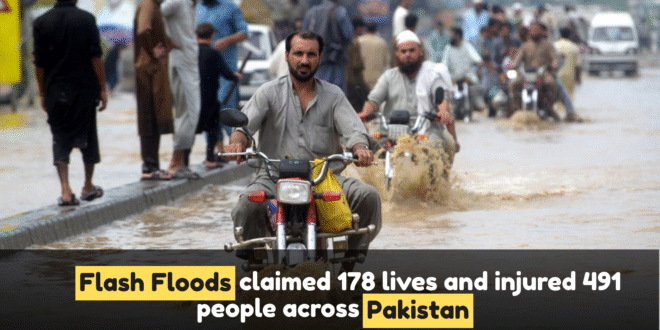Devastating New Death Toll Amid Ongoing Monsoon Deluge
In the past 24 hours, torrential monsoon rains in Pakistan have worsened the already catastrophic flood situation. Official reports confirm that at least 54 people died and 227 were injured in just one day, pushing the overall toll since late June to around 178 deaths and nearly 500 injured. The National Disaster Management Authority (NDMA) has stated that the intensity and frequency of these rainfalls have overwhelmed both rural and urban infrastructures.
Punjab Bears the Brunt as “Rain Emergency” Declared
Punjab has been the worst affected region, with 30 fatalities and hundreds injured in the last 24 hours. The areas most impacted include Chakwal, Rawalpindi, Lahore, and Faisalabad. Due to the severe conditions, the provincial government has declared a “rain emergency” in several districts. Rescue teams, police, and medical units have been dispatched, and a public holiday was announced in many areas to prevent travel and reduce risks to public safety.
Mountains, Rivers and Collapsed Homes: Widespread Impact
Since June 26, heavy downpours have brought destruction across Pakistan, with Chakwal receiving over 400 mm of rain—far exceeding the July average. As a result, houses collapsed, rivers overflowed, and landslides blocked highways. In Khyber Pakhtunkhwa (KP), over 30 people have died so far, particularly in districts like Swat, Shangla, Abbottabad, and Charsadda. Many of the deaths occurred when people were swept away during flash floods or crushed under debris from collapsed structures.
Emotional Toll and Public Reaction
The flash floods have deeply impacted the lives of thousands, leaving families homeless and communities stranded. Social media has been filled with disturbing videos and stories from the affected areas. In one widely shared clip, a reporter was nearly swept away by floodwaters during a live broadcast near Chahan Dam, raising public concerns about the safety of media professionals in extreme weather coverage.
Climate Crisis Amplifies Recurrent Disasters
Experts are linking these repeated flood disasters to the growing threat of climate change. Melting glaciers in the northern regions and erratic monsoon patterns are creating more extreme weather events. Pakistan’s weak drainage infrastructure and rapid urbanization only worsen the problem. Without long-term investment in climate resilience, such disasters may become more frequent and deadly in the coming years.
FAQs
1. How many have died and been injured so far?
A: As per the latest updates, around 178 people have died and nearly 491 have been injured across the country since the start of the monsoon season in late June.
2. Which regions are most affected?
A: Punjab is the worst-hit province, especially cities like Chakwal, Lahore, and Rawalpindi. Khyber Pakhtunkhwa has also experienced significant damage and loss of life.
3. What are the main causes of these floods?
A: The main causes include record-breaking monsoon rainfall, glacier melt, blocked waterways, and inadequate flood prevention infrastructure.
4. What actions has the government taken?
A: The government has declared emergencies in several regions, deployed rescue teams, and arranged temporary shelters. Relief efforts are underway, though challenges remain due to continued rain.
5. Are children among the casualties?
A: Yes, a significant number of casualties include children, especially in cases where homes collapsed or when they were caught in rising waters.




